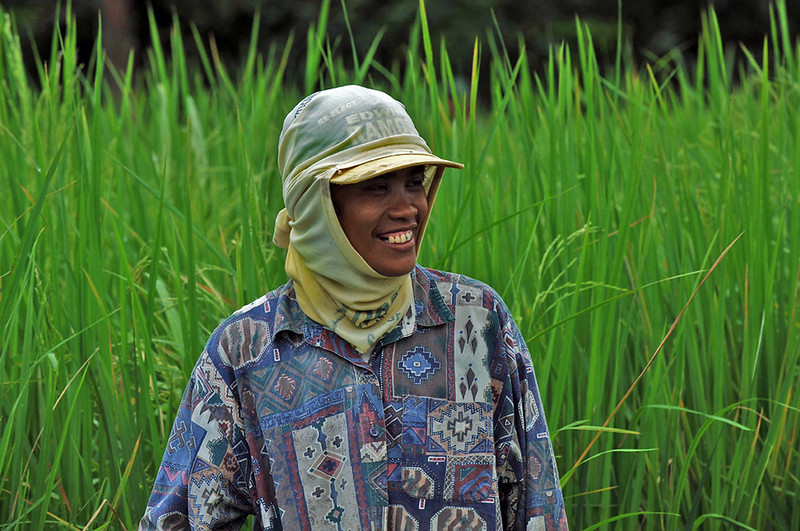
Agriculture is a significant source of greenhouse gas emissions and thus both a contributor to the climate change crisis and one of the sectors most adversely affected by rising temperatures, longer periods of drought, and sudden floods. Climate change is a reality that we all live with today, and often the ones who bear the brunt of its effects are those already vulnerable and marginalized. As a result, climate change science and research often work to enhance resilience to climate shocks and impacts. In this space, we often hear of climate-smart agriculture (CSA) as a means to enhance resilience.
CSA includes technologies and practices that enhance adaptation, reduce greenhouse gas (GHG) emissions, and improve food security. It also includes drought-tolerant crop varieties, conservation agriculture, agroforestry, and soil and water conservation. The development and scaling of CSA has been one area of focus in this move to enhance resilience. Once the appropriate technology or practice is identified, however, the challenge then lies in scaling it up through dissemination across target populations or communities – one that has been taken up by international organizations such as FAO and numerous NGOs.
The Intergovernmental Panel on Climate Change (IPCC) Working Group 2 Report also warns of the danger that such types of climate response can bring to the most vulnerable communities whose well-being they are trying to improve. The climate response can inadvertently lead to “maladaptation,” where interventions reinforce existing vulnerabilities, either by benefiting elites or transferring risks between groups.
Basically, what this means is that adaptation can create new risks and sources of vulnerability for some farmers, as a result of technical adaptation programming that is driven by external objectives and often insufficiently considers the social and political dimensions of vulnerability.
While there is a lot of literature on the success of CSA in terms of the number of farmers practicing CSA, there are few examples of success in the context of human development. Narratives and discourses around CSA often fail to emphasize societal concerns, including issues of inequality, power dynamics, and justice. Often those who benefit from CSA tend to be elite farmers who do so at the expense of the more vulnerable and marginalized. Failing to recognize this dimension of CSA and a lack of acknowledgment of structural socio-economic and power dynamics leaves some types of farmers even more vulnerable to climate shocks and impacts. This undermines the ability of CSA to reduce rural poverty and often ends up further reinforcing already existing inequalities.
Transformative approaches, therefore, must consider social contexts and power relations through which agriculture is both researched and practiced. Resilience encompasses both agro and socio-ecological dimensions and can only truly be enhanced by embedding a social equity lens in agricultural practices. Transformative change cannot take place without the inclusion of social equity issues embedded at the fore, and the recognition of power dynamics and decision-making processes within the context of agricultural development. The IPCC report highlights this emphasis on transformative adaptation and the need to tackle the root causes of vulnerability to climate change; it is this greater emphasis on social equity that distinguishes climate-resilient from climate-smart agriculture.
In this recently published journal article: Transformative adaptation: From climate-smart to climate-resilient agriculture, which we will discuss during a session, titled “Transformative and art-based methods for integrating community voices: From concepts to operationalization,” a workshop featuring ClimBeR at the upcoming Tropentag conference, and based on our experiences as CGIAR researchers who are a part of the CGIAR Initiative on Climate Resilience (ClimBeR) in South Asia, sub-Saharah Africa, and Latin America, we elaborate on these specific themes and demonstrate the importance of reorienting the climate response from climate-smart to climate-resilient by giving more emphasis to social equity.
A truly transformative approach requires a broader and more comprehensive understanding and appreciation of farmers’ realities, and the changes needed to bring about large-scale transformation for their livelihoods, while either avoiding or mitigating the dangers of maladaptation. There needs to be a paradigm shift from technological innovation to social equity governance and policy. It also equally requires greater attention to the active participation of farmers and farmers groups in defining the key challenges that they face, to identify appropriate and relevant innovations in response.
Transformative adaptation cannot take place without the integration of social equity. What distinguishes climate-resilient from climate-smart agriculture is not the lack of innovation but rather a greater emphasis on human well-being, a greater prioritization of whose best interest (of those most vulnerable) but most of all a focus on the societal, cultural, and political dynamics that surround those most vulnerable and whose lives and livelihoods are affected by climate shocks and impacts the most.
Learn more here:
Side-event at Tropentag2023: “Transformative and art-based methods for integrating community voices: From concepts to operationalization,” a workshop featuring CGIAR’s Research Initiative on Climate Resilience
Feature image photo credit: International Rice Research Institute.



